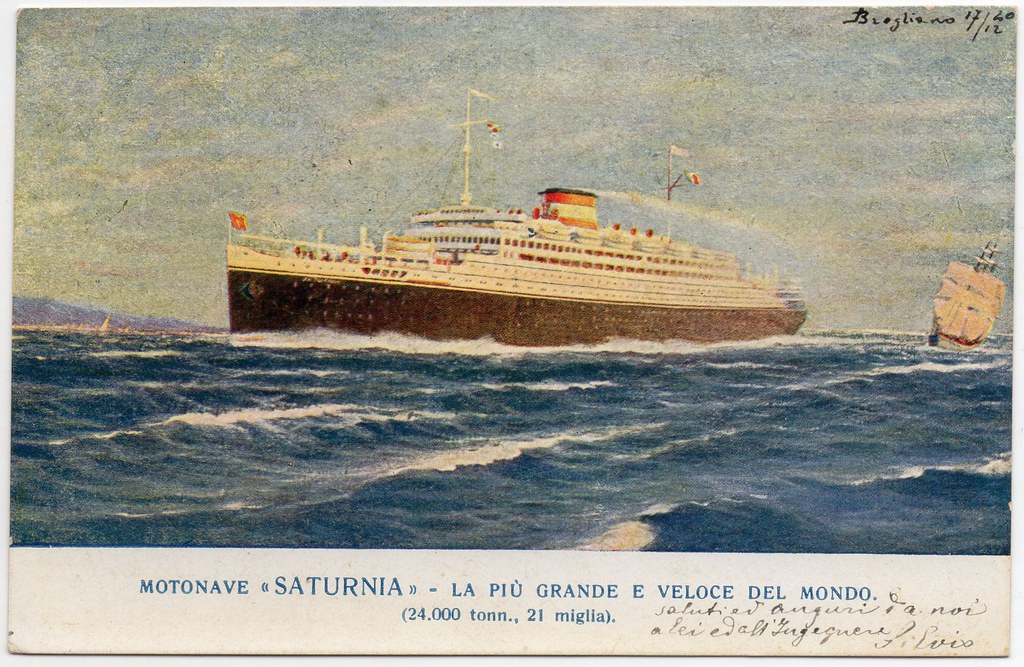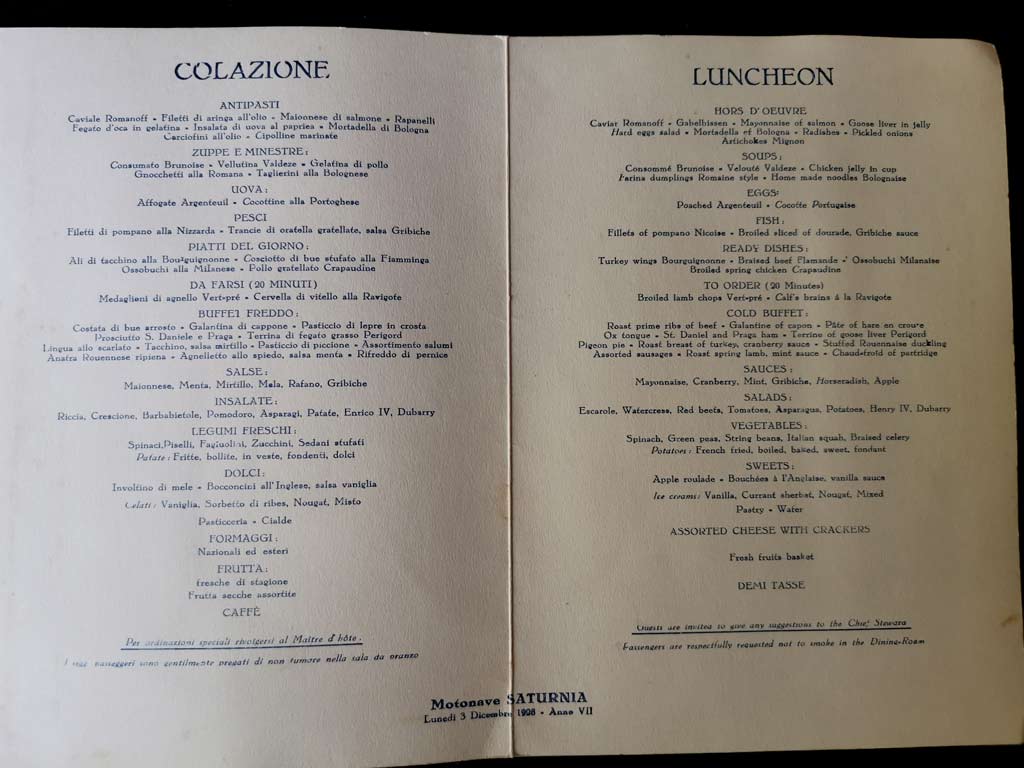1st December 1928 / A cruise breakfast on the Saturnia
Time machine does not always proceed backwards towards extraordinary and memorable days. Actually, 1 December 1928 appears as an ordinary working day. Yet, behind the crumpled and...
Filter by Category
Time machine does not always proceed backwards towards extraordinary and memorable days. Actually, 1 December 1928 appears as an ordinary working day. Yet, behind the crumpled and...
Foreword by Giovanna Frosini Materials, shapes, colours, flavours: the language of food transforms all this into words, it coats with sounds a fundamental and daily experience,...
There is the scent of freshly cut grass in the air, the grass of the magnificent gardens of Villa Bardini, on Costa S. Giorgio, overlooking Florence. The Villa takes its name from...
Food in the cinematic imagination From its origins, cinema has described the relationship between man and money, investing it with cultural connotations that range from ethnic to...
Officina Profumo-Farmaceutica di Santa Maria Novella in Florence is one of the oldest pharmacies in the world, founded by the Dominican friars in 1221 and open to the public since...
It’s a sunny day; the hot coffee is excellent. We are sitting next to the window inside the bar where we agreed to meet for our interview. The smile of Anna Maria Visconte,...
when art masterpieces inspire healthy and tasty recipes Take the professionalism and passion of an art critic, Caterina Corni, with the passion for contemporary Indian art, the...
The adventure of our magazine starts with young people and a mission announced as quite dangerous. On an almost spring morning, we have had a long conversation with the girls and...
Leonardo da Vinci: a genius in the kitchen We have used to it. After Dan Brown’s and Marco Malvaldi’s Leonardo, we are all somehow “from Vinci”, especially in this...
We are used to making lists and catalogues, especially now that our phones measure everything, our steps, and the time we spend on the phone or on social media or disposing of...
Time machine does not always proceed backwards towards extraordinary and memorable days. Actually, 1 December 1928 appears as an ordinary working day. Yet, behind the crumpled and dusty sheet of that old calendar, it is possible to rediscover a surprising picture of light, life and colour.

Salone della Saturnia. Una delle foto della mostra “Saturnia e Vulcania: motonavi da record” visitabile a Monfalcone, alla Galleria d’Arte Contemporanea dal 4 al 20 settembre 2015 (Foto Italian Liners)
The Saturnia, one of the first diesel-powered ocean liners, is sailing towards North and South America with its variegated load of humanity. Owned by the Trieste-based ship-owner Cosulich, she sailed on her maiden voyage on 21 September 1927, headed for the South American port of Plata. From 1 February 1928, it would also head towards New York.

Two hundred meters in length, the Saturnia offers as many as four classes to more than two thousand passengers, with the addition of five-hundred crewmembers. The ship is built to please very different needs and dreams: emigrants in search of fortune either North or South America; the rich clientele of American cruise passengers who headed for the Old Continent.
Through functional techniques and cutting-edge design, the ocean liner was the first in the world to have first-class cabins with an outdoor veranda. The access to the halls was also well finished and quite magnificent, starting from the internal monumental staircase “guarded on the top by a bronze statue of the deity that gave its name to the ship […]. It rises from the lobby to the promenade deck and descends to the lower floors where the swimming pool hall, a sumptuous reproduction of the magnificent Pompeian baths, is”.
The decoration of the dining room also recalled the classicism. Here, in the long marble band at the base of the dome, one could identify the same ornamental motifs of the Parthenon.
It is worthwhile to linger in this very special room for a few more moments. On 1 December 1928, on one of the tables prepared for 1st class passengers, we find the menu we have managed to bring out from oblivion. Translated also into English, the menu was specific for the breakfast of the day, hence an unprecedented.

Despite the very wide choice of the menu, the footnote is very interesting: for special orders, contact the “Maître d’hôtel”.
The offer of appetizers is wide and rich, balancing, even linguistically (considering the historical context of fascism), Italian delicacies and the attention to the international audience: Romanoff caviar – herring fillets in oil – salmon mayonnaise – goose liver in jelly – egg salad with paprika – radish – bologna – artichokes in oil – marinated onions.
In the “soups and broths” section stand out, among others, the Brunoise cut (with evenly cut vegetables, diced about two mm per side), the Roman semolina gnocchi, Bolognese taglierini, and the Waldensian pureed soup.
Before the dishes of the day, some delicious intermezzos, including the drowned eggs à l’Argenteuil (a specific quality of asparagus, with a white stem and green-violet tip) and little Portuguese casseroles (coddled eggs laid on a bed of tomatoes, vegetables and ricotta). Fish can be found in this gastronomic offer, such as, for example, the Nicoise pompano fillets (baked together with tomato and onions, fish stock, white wine and olive garnish).
To finish the “hot” part of the breakfast, we move to the principal and intense dishes of the day: Milanese-style ossobuco, and beef leg stewed in the Flemish style (beef stew cooked very slowly in Belgian beer along with onions and herbs). Grilled Crapaudine chicken (split in two and previously marinated all night long in a mix of white wine, lemon juice, garlic, parsley, Piri Piri, paprika, thyme, and bay leaves). Burgundian-style turkey wings (with minced onion, mushrooms and many of the ingredients mentioned above, with the addition of butter and pepper of various types). Calf brain with Ravigote sauce (sauce with a vegetable or meat broth base, with herbs and lemon, often added with Dijon mustard).
The “cold buffet” is also extremely rich. Apart from the wide assortment of Italian and non-Italian cold cuts, there were special game delicacies (cold partridge, hare pie) and the more classic pigeon pie, Perigord foie gras terrine and capon galantine.
There is no shortage of salads, transversal to the entire breakfast, from the traditional ones to the more “royal” one dedicated to Henry IV (with barley, melon, provola cheese and crunchy culatello), or more studied combinations such as fondant potatoes and stewed celery.
Scrolling the order of the breakfast list, it is the turn of desserts and ice creams, among which stand out the English morsels, the apple roulade and the currant sorbet. Followed by “domestic and foreign cheeses”, assorted fresh seasonal fruit and dry fruit.
This long tasty sequence could not have ended without the coffee, which, with an international flavour, is defined as “Demi tasse”, an elegant designation meant to avoid, yesterday as today, unpleasant surprises.

A thought goes to that anonymous first-class passenger who, between a course and another of that 1 December 1928 breakfast, took note of an intriguing sauce on the back of the menu that has accompanied us in this experience. Such sauce, at a distance of almost a hundred years, still smells of rosemary, thyme, a tablespoon of curry powder and 10 grains of pepper. A bit of Proust on the old Saturnia…